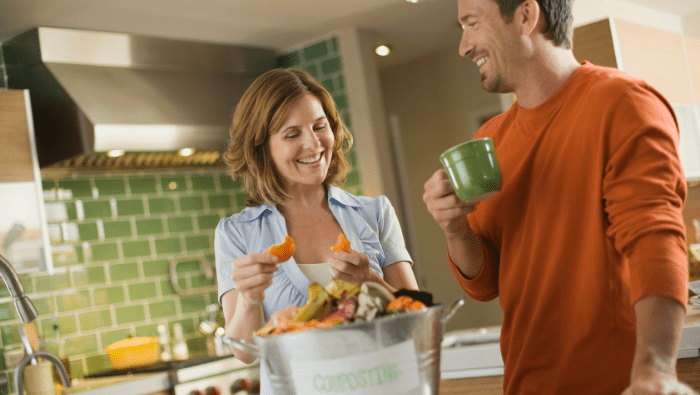How To Get Started Composting on the Cheap
by Debra Karplus

We explore the benefits of composting your household scraps as well as how to get started composting on the cheap.
You are certain that you’re paying too much for garbage hauling services. Reducing what you throw away is the obvious best method for lowering your garbage bill, having fewer garbage buckets and less frequent pick-up. One way to have less trash is to purchase fewer packaged items, especially when grocery shopping.
Another way to decrease what you discard is to compost. Composting is definitely not a case of garbage in, garbage out. Your garbage going in will magically transform into rich organic fertilizer that you put in your garden to help it thrive. Your healthiest and cheapest way to fertilize a garden is to make your own organic compound by composting.
Even if your property only has shrubbery and not a garden, homemade compost has many benefits.
Making good compost is amazingly simple.
You don’t have to be an expert at anything to make good compost. No precision is involved. You don’t have to measure or weigh anything, nor do you need to monitor temperature or time.
Most waste from your kitchen is perfect for composting, with the exception of bones or meat. Egg shells, coffee grounds, apple cores, and other inedible parts of the food you enjoy will find a proper home in your compost pile.
Yard waste is another ingredient to good compost. The smaller it is, the quicker it will decompose, so don’t put huge branches into the pile.
Grass clippings and leaves are wonderful additions to your compost. If you’re cutting firewood, the wood chips and bark left behind can be composted.
Wood ashes from your fireplace or wood stove can be in your compost, but only in small quantities as they change the pH of the compost because they are so alkaline.
You can start a compost pile anytime of year; adding to it is ongoing. Heat and air are your compost pile’s best friend. Heat will come from the sun and higher air temperatures.
For a compost pile to properly aerate, it must be turned periodically either by you with a shovel or pitchfork, or by having your compost in a container designed to turn it.
Sign Up for Savings
Subscribe to get money-saving content by email that can help you stretch your dollars further.
Twice each week, you'll receive articles and tips that can help you free up and keep more of your hard-earned money, even on the tightest of budgets.
We respect your privacy. Unsubscribe at any time.
Your compost container can be plain or fancy and homemade or store-bought.
It’s prudent to store your compost on your property away from the house or garage, in case it has an odor or attracts pests. However, a properly managed compost bin should do neither.
DIY compost bins
The cheapest way to have a compost bin is to build your own. Many people use pallets, also called skids, which are available free in places around town, such as shops or your newspaper circulation loading dock. Just ask.
Look online to see instructions and photos for making compost bins or be creative and design your own from free materials that you find or have laying around your basement or garage. You can build it whatever size you choose. Remember to turn the contents occasionally for aerating using a garden tool.
Store-bought compost bin options
There are also containers designed specifically for composting that can be purchased from a home improvement shop or garden center. Though there are vendors that sell them online, the shipping and handling costs might make buying locally the better deal. (See 11 Ways to Save at Home Depot.)
A compost bin, sometimes made of plastic, sells for fifty dollars or more. Often green-colored to blend in with your yard, they have an opening at the top for dumping in your food and yard waste. They also have small holes on the sides to allow air in but keep rodents and insects out, and an opening at the bottom to shovel rich compost out from it and onto your garden. These bins tend to be lightweight and small enough to move to a different spot in your yard if you desire.
A compost tumbler costs at least $150 or as much as several hundred dollars depending on how large a tumbler you select. A tumbler sits on a stand and is usually barrel-shaped with a handle to facilitate turning and aerating. Peruse tumblers online to see pictures and get an idea of the prices.
Stretching dollars and going green often go hand-in-hand. Thus is the case with making your own organic compost. You’ll be preventing your food scraps and yard waste from being in the landfill while enriching your home garden or greenery.
Experiment with a small homemade compost bin to get started. You’ll be pleased with the results.
Reviewed March 2023
About the Author
Debra is an occupational therapist, accountant, teacher and freelance writer. Learn more about her at DebraKarplus.blogspot.com.
Wouldn't you like to be a Stretcher too?
Subscribe to get our money-saving content twice per week by email and start living better for less.
We respect your privacy. Unsubscribe at any time.
Popular Articles
On After50Finances.com
- 9 Things You Need to Do Before You Retire
- You Didn’t Save Enough for Retirement and You’re 55+
- When Empty Nesters Reorganize and Declutter Their Home
- Reinventing Your Career in Your 50s or 60s
- What Mature Homeowners Should Know about Reverse Mortgages
- 2 Reasons to Collect Social Security Benefits As Soon As Possible


